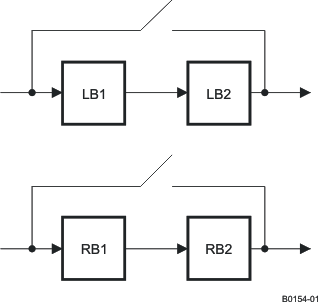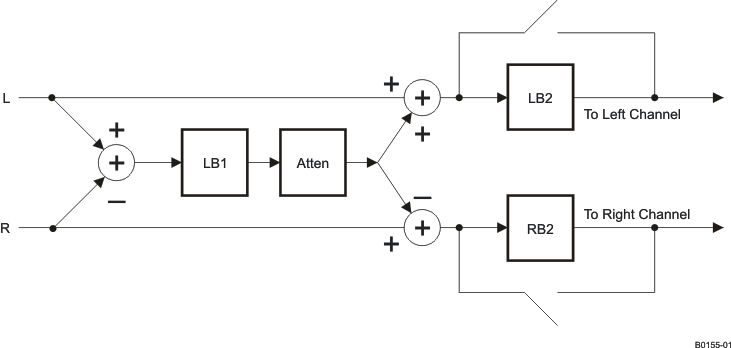SLAS510G March 2007 – February 2021 TLV320AIC3104
PRODUCTION DATA
- 1 Features
- 2 Applications
- 3 Description
- 4 Revision History
- 5 Description (Continued)
- 6 Device Comparison Table
- 7 Pin Configuration and Functions
- 8 Specifications
- 9 Parameter Measurement Information
-
10Detailed Description
- 10.1 Overview
- 10.2 Functional Block Diagrams
- 10.3
Feature Description
- 10.3.1 Hardware Reset
- 10.3.2 Digital Audio Data Serial Interface
- 10.3.3 Audio Data Converters
- 10.3.4 Stereo Audio DAC
- 10.3.5 Audio Analog Inputs
- 10.3.6 Analog Fully Differential Line Output Drivers
- 10.3.7 Analog High-Power Output Drivers
- 10.3.8 Input Impedance and VCM Control
- 10.3.9 MICBIAS Generation
- 10.3.10 Short-Circuit Output Protection
- 10.3.11 Jack and Headset Detection
- 10.4 Device Functional Modes
- 10.5 Programming
- 10.6 Register Maps
- 11Application and Implementation
- 12Power Supply Recommendations
- 13Layout
- 14Device and Documentation Support
Package Options
Refer to the PDF data sheet for device specific package drawings
Mechanical Data (Package|Pins)
- RHB|32
Thermal pad, mechanical data (Package|Pins)
- RHB|32
Orderable Information
10.3.4.1 Digital Audio Processing for Playback
The DAC channel consists of optional filters for de-emphasis and bass, treble, midrange level adjustment, speaker equalization, and 3-D effects processing. The de-emphasis function is implemented by a programmable digital filter block with fully programmable coefficients (see page 1, registers 21–26 for the left channel and page 1, registers 47–52 for the right channel). If de-emphasis is not required in a particular application, this programmable filter block can be used for some other purpose. The de-emphasis filter transfer function is given by:

where the N0, N1, and D1 coefficients are fully programmable individually for each channel. The coefficients that should be loaded to implement standard de-emphasis filters are given in Table 10-3.
| SAMPLING FREQUENCY | N0 | N1 | D1 |
|---|---|---|---|
| 32 kHz | 16,950 | –1,220 | 17,037 |
| 44.1 kHz | 15,091 | –2,877 | 20,555 |
| 48 kHz(1) | 14,677 | –3,283 | 21,374 |
In addition to the de-emphasis filter block, the DAC digital effects processing includes a fourth-order digital IIR filter with programmable coefficients (one set per channel). This filter is implemented as cascade of two biquad sections with frequency response given by:

The N and D coefficients are fully programmable, and the entire filter can be enabled or bypassed. The structure of the filtering when configured for independent channel processing is shown in Figure 10-10, with LB1 corresponding to the first left-channel biquad filter using coefficients N0, N1, N2, D1, and D2. LB2 similarly corresponds to the second left-channel biquad filter using coefficients N3, N4, N5, D4, and D5. The RB1 and RB2 filters refer to the first and second right-channel biquad filters, respectively.
 Figure 10-10 Structure of Digital Effects Processing for Independent Channel Processing
Figure 10-10 Structure of Digital Effects Processing for Independent Channel ProcessingThe coefficients for this filter implement a variety of sound effects, with bass boost or treble boost being the most commonly used in portable audio applications. The default N and D coefficients in the part are given in Table 10-4 and implement a shelving filter with 0-dB gain from dc to approximately 150 Hz, at which point it rolls off to a 3-dB attenuation for higher frequency signals, thus giving a 3-dB boost to signals below 150 Hz. The N and D coefficients are represented by 16-bit, 2s-complement numbers with values ranging from –32,768 to 32,767.
When in Independent Channel Processing Configuration
| Coefficients | ||||
|---|---|---|---|---|
| N0 = N3 | D1 = D4 | N1 = N4 | D2 = D5 | N2 = N5 |
| 27,619 | 32,131 | –27,034 | –31,506 | 26,461 |
The digital processing also includes capability to implement 3-D processing algorithms by providing means to process the mono mix of the stereo input, and then combine this with the individual channel signals for stereo output playback. The architecture of this processing mode, and the programmable filters available for use in the system, are shown in Figure 10-11. Note that the programmable attenuation block provides a method of adjusting the level of 3-D effect introduced into the final stereo output. This, combined with the fully programmable biquad filters in the system, enables the user to optimize the audio effects for a particular system and provide extensive differentiation from other systems using the same device.
 Figure 10-11 Architecture of the Digital Audio Processing When 3-D Effects Are Enabled
Figure 10-11 Architecture of the Digital Audio Processing When 3-D Effects Are EnabledIt is recommended that the digital effects filters should be disabled while the filter coefficients are being modified. While new coefficients are being written to the device over the control port, it is possible that a filter using partially updated coefficients may actually implement an unstable system and lead to oscillation or objectionable audio output. By disabling the filters, changing the coefficients, and then re-enabling the filters, these types of effects can be entirely avoided.